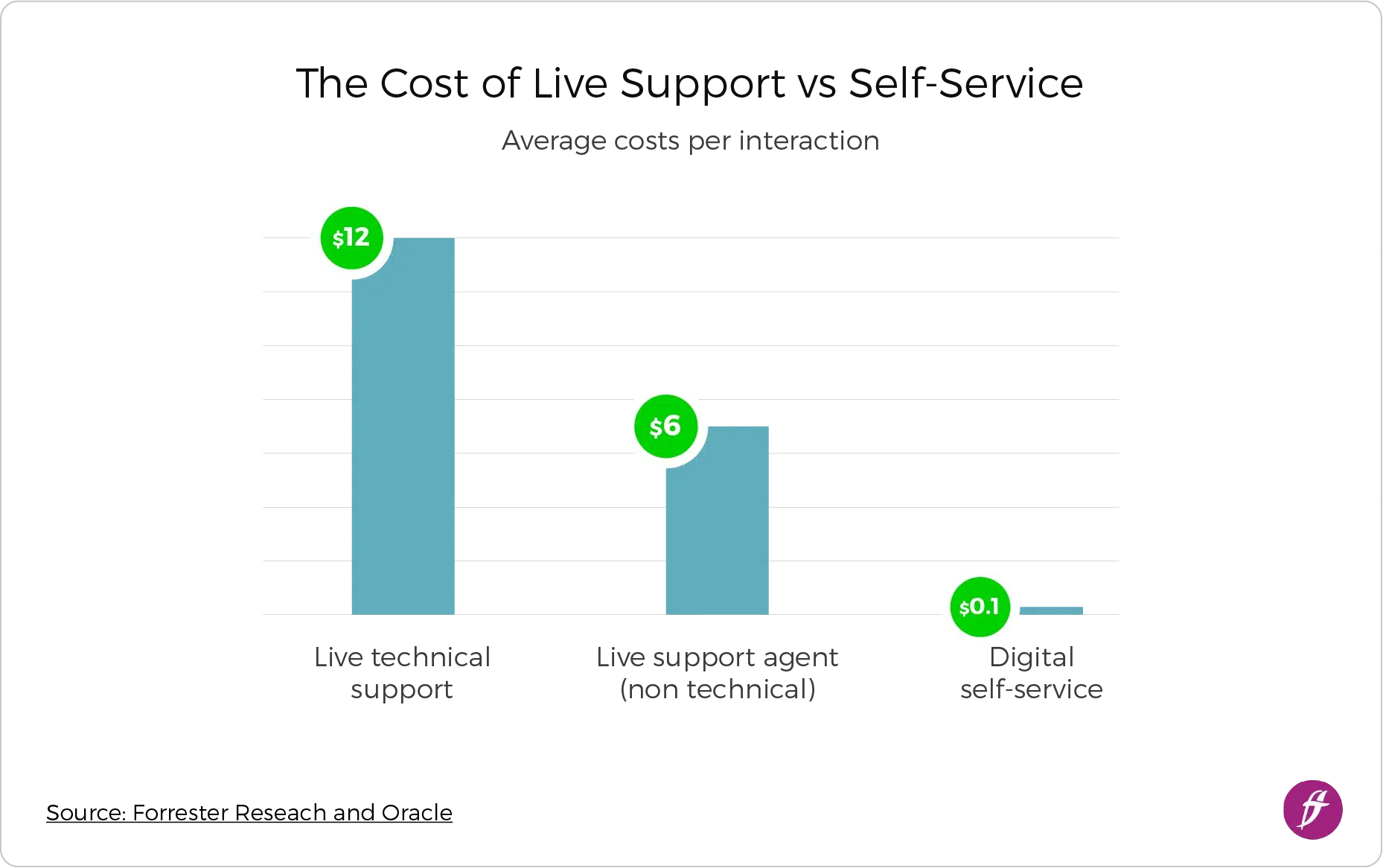
5 Ways Product Knowledge Platforms Save Companies Millions
Learn how Fluid Topics customers are saving big thanks to five of the core benefits of using our Product Knowledge Platform.

Table of Contents
- What is a Product Knowledge Platform?From CDP to PKP
- 1. By Reducing the Time to Find Information
- How a PKP Makes This Possible
- How Fluid Topics Drives Million-Dollar Savings
- 2. By Cutting Support Costs
- How a PKP Makes This Possible
- How Fluid Topics Drives Million-Dollar Savings
- 3. By Accelerating Documentation Portal Deployment
- How a PKP Makes This Possible
- How Fluid Topics Drives Million-Dollar Savings
- 4. By Boosting SEO Traffic
- How a PKP Makes This Possible
- How Fluid Topics Drives Million-Dollar Savings
- 5. By Reducing Environmental Impact
- How a PKP Makes This Possible
- How Fluid Topics Drives Million-Dollar Savings
- How Much Will You Save?
Documentation may largely be digital today, but is it providing value? Just because you turned bulky manuals gathering dust into digital PDFs doesn’t mean the user experience has improved or your business is seeing the ROI they desire. Using authoring tools to write structured content is a great start, but until your delivery, search, and engagement experiences change, users will continue to face disappointment, leading to unnecessary costs. Let’s be honest…it is challenging for users to search through static documentation to find the precise information they need. Thankfully, modern tools simplify the process, extracting relevant information personalized to each user, creating new opportunities for customer engagement, and driving savings for companies.
Organizations looking to take their documentation experiences to the next level while driving million-dollar savings are investing in Product Knowledge Platforms (PKPs) like Fluid Topics. These innovative solutions are the next evolution of Content Delivery Platforms (CDPs), expanding the possibilities to optimize customer support and field service operations. Below, we highlight five business benefits that PKPs provide, explore real-life case studies of Fluid Topics clients that experience these advantages, and highlight how this technology drives savings.
What is a Product Knowledge Platform?
From CDP to PKP
Before we get into the benefits, we need to break down what a Product Knowledge Platform is and how it evolved from the Content Delivery Platform.
Content Delivery Platforms were initially developed to serve as a unified hub of product and technical content as well as to reinvent the way users can search for and read information. They are defined by several capabilities.
- CDPs signaled the end of static HTML pages and documents. Companies using a CDP offer harmonized content that is dynamically assembled and delivered to meet each user’s needs, context, and profile (also known as “dynamic delivery”).
- These platforms offer the capability to deliver documentation from any content source to any user touchpoint with APIs (e.g., to in-product help tools).
- As a platform, a CDP is open (API-first), comprehensive, configurable for building on top of it, robust, and secure. When it comes to Fluid Topics, our platform includes advanced search technology, dedicated content analytics dashboards, modules to transform and enrich content, user access rights for gated content, and more.
While CDPs initially focused solely on technical documentation, at Fluid Topics we noticed the emergence of new user groups and content types, including API documentation, parts catalogs, data sheets, knowledge base articles, help desk tickets, and more. Therefore, we recognized that the term “Content Delivery Platform” was no longer reflective of the solution’s purpose or capabilities.
Today, customers are facing increasingly complex and evolving challenges, resulting in the development of two new capabilities:
- Generative AI (GenAI): GenAI is transforming how users find and engage with information rather than the entire content. AI is good at getting to the heart of what information users need to extract and understand from within documentation.
- User Contributions: Companies value direct user feedback, driving new opportunities for users to comment, annotate, and collaborate on content. This helps documentation teams capture knowledge from the field to integrate learnings and best practices into their content.
As the purpose and capabilities of the CDP expanded, Fluid Topics was redefined as a “Product Knowledge Platform” to accommodate these changes. In short, CDPs moved us from unstructured, static documents to dynamically delivered granular content, and now, PKPs take us from content to action-oriented information and user interactions.
With this understanding of Product Knowledge Platforms in mind, let’s look at the five ways PKPs like Fluid Topics save companies millions.
1. By Reducing the Time to Find Information
Whether it’s a technician fixing a machine, a customer setting up a product, or a sales rep prepping for a meeting, time spent searching for the right content is time lost. McKinsey reported that employees spend nearly 20% of the work week just looking for internal information or contacting colleagues for help.
This inefficiency results in:
- Slower support and service resolution
- Delayed sales and project cycles
- Higher operational costs
- Increased customer and employee frustration
How a PKP Makes This Possible
Product Knowledge Platforms solve this by delivering just-in-time, contextual content. Unlike static PDFs, dynamic systems leverage structured data, metadata, advanced search technology, and AI to deliver precisely the information users need, exactly when and where they need it. For example, a service technician scans a QR code and instantly retrieves maintenance instructions tailored to the product’s serial number, version, and location. A customer accesses help content that adjusts to their product model and language preferences automatically.
But this doesn’t happen by chance; it requires modern content processes built on two key pillars:
1. Structured Content and Metadata
The foundation of findable information is content that’s modular and well-organized. Structuring content into topics using standards like DITA and S1000D eliminates duplication, improves reuse, streamlines translation processes, and makes it easier for both people and AI tools to navigate. Metadata tags describe the purpose and context of each topic, making them more discoverable by search engines and recommendation systems.
2. Real-Time Dynamic Delivery
Even the best-structured content loses its value if it’s locked in static formats like PDFs. That’s why real-time delivery matters. Platforms like Fluid Topics reassemble documentation on the fly when a user accesses it. This ensures that users always receive the most up-to-date, personalized version of the content.
PKPs combine these content processes with semantic search technology to ensure users seamlessly find information via a cohesive search experience across touchpoints.
Fluid Topics: Your Semantic Search Solution for Relevant Results
But don’t take our word for it! Aurélien Unfer, Project Manager, New Information and Communication Technologies at Liebherr Mining, affirmed the value of Product Knowledge Platforms when he said that “Fluid Topics has enhanced the search experience. The portal improves the way users can navigate our content, allowing them to find solutions in a snap and improve service levels.”
"A maximum of 3 clicks" [is deemed acceptable while searching for product documentation].
Jos Taabe
Manager of Global Technical Training and Documentation at Thermo Fisher Scientific
How Fluid Topics Drives Million-Dollar Savings
Customers leveraging Fluid Topics have reported 50–75% reductions in search time. One leading supplier of analytical instruments measured their results after launching a dynamic documentation portal for their field service team. On average, they saved 800 hours of technician time each month, translating directly into 800 additional hours of productive service. For them, adopting a dynamic content delivery approach wasn’t just a technology upgrade, it was a clear operational win.
2. By Cutting Support Costs
It’s no surprise that customer support teams are overwhelmed with support requests, and with 57% of customer leaders predicting support calls will increase by 20% over the next few years, companies need innovative solutions. Currently, when information is hard to find, customers either spend hours poring through documentation, at which point they may or may not find what they need, or they need to open help desk tickets, which are tedious and time consuming for support teams. Either way, the process is slow and overly complex, leading to wasted time and skyrocketing support costs to keep up with user demand.
How a PKP Makes This Possible
Product Knowledge Platforms address these challenges in different ways:
- By empowering users to help themselves with accurate, relevant content customized to their specific products.
- By giving agents quick access to everything from technical documentation and knowledge base articles to past tickets and more, all from a single source of truth.
- By providing contextual help that shows the right information exactly when it’s needed, whether integrated within support tools or directly accessible on product interfaces. Customers can therefore use self-service options to find answers on their own without having to open support tickets.
- By leveraging GenAI to offer natural, conversational experiences through chatbots, guide users through complex troubleshooting steps, or extract personalized responses instantly. This not only reduces ticket volumes but also allows support agents to focus their time on handling more complex or high-value issues that require human expertise.

Johannes Müller, Technical Communication Leader of swissQprint, confirmed these benefits of Product Knowledge Platforms when he stated, “We saw the impact almost immediately. In the first month after launching the self-service technical documentation portal we saw a drop in the number of service tickets of 34%! The adoption by our partners, resellers, and users of the self-service portal was rapid, and technicians were eager to have access to an alternative to a phone-centered help desk.”
How Fluid Topics Drives Million-Dollar Savings
Fluid Topics’ Product Knowledge Platform offers a turnkey portal that allows companies to publish their content to the portal and create a single source of truth from which agents and users alike can quickly access the product knowledge they need. This portal facilitates documentation access, ensures contextually relevant results for each user’s profile, and empowers users with self-service support. These elements drive ticket deflection and reduce support costs.
Fluid Topics also brings AI into your support process with a smart assistant and an integrated chatbot, both powered by your centralized knowledge base to deliver up-to-date and relevant answers. These tools automate answers to customer inquiries and allow support agents to review and tailor responses before sending. This combination speeds up resolution times, enhances service quality, and reduces ticket handling efforts by up to 50%.
"Integrating our help content with a chatbot helped us achieve a 65% support deflection rate, saving time while empowering users to find answers on their own.”
Sagar Garuda
Senior Director of Learning at Darwinbox
3. By Accelerating Documentation Portal Deployment
Documentation portals serve as a crucial platform for delivering up-to-date, tailored information directly to users. Yet, building and maintaining a documentation portal from scratch is time-consuming and highly expensive for companies.
How a PKP Makes This Possible
Leading Product Knowledge Platforms seamlessly consolidate product and technical documentation from various sources and formats into a unified knowledge hub. Fluid Topics also offers a content portal with must-have features like a WYSIWYG, fully configurable portal designer to maximize its benefits.
This was the right solution for Vaisala as Katy Greatrex, then Commercial Product Information Manager, noted that “As a no-code cloud-based solution, Fluid Topics is very easy to use and maintain for our team. We can customize the front-end, such as the portal’s look and feel. But we can also customize business functionalities, like the metadata-driven filtering, from the administration console, with full autonomy, and have a low dependency on IT support. This autonomy is one of the main reasons we chose Fluid Topics.”
How Fluid Topics Drives Million-Dollar Savings
A PKP like Fluid Topics reduces this burden by providing a turnkey portal that offers the necessary functionalities and modules for rich content experiences and integrates seamlessly with existing systems. Rather than dedicating IT resources to custom portal development, companies can autonomously deploy a centralized, searchable, and user-friendly portal in a fraction of the time and without massive overhead costs. This site becomes a valuable place for both internal and external users to find product information quickly and easily, driving sales, reducing support costs, and optimizing team efficiency.
“Fluid Topics enhanced our operations by unifying our content and centralizing our publishing, allowing us to instantly communicate about 1 million products across 60 websites and 25 portals. The time saved and the improved user experience? That’s true value.”
Nelson Abbey
Principal Information Developer at Johnson Controls International
4. By Boosting SEO Traffic
Companies are great at improving their corporate website SEO but often overlook opportunities to improve product awareness and brand visibility thanks to product documentation. This missed opportunity is costing them as 54% of businesses believe their documentation generates at least as many leads as their marketing sites.
How a PKP Makes This Possible
Technical documentation portals offer a valuable reserve of content to improve organizations’ internet search references. Top-of-the-line content publishing tools make it easy for companies to apply SEO principles such as adding metadata and allowing search engines to crawl and index public product content to harness this untapped resource. As a result, they will transform their portals into high-traffic sites with first page rankings for relevant product keywords.
Teradata is already taking advantage of this opportunity. They even provide their technical writers with a document on how to write for SEO to help them optimize their content for web search engines. With 90% of their traffic coming through web searches, it’s clear that this strategy can produce major results.
Teradata's technical documentation website is now the company's most visited website with over 5 million visits in the last year alone.
Beth McFadden
Technical Project Manager for Content Operations at Teradata
Fellow Fluid Topics customer, Hexagon, saw similar results as Lonnye Yancey-Smith, Executive Manager at Hexagon explained. “Before we launched with Fluid Topics in early 2019, the visibility of our documentation via Google was zero. By 2020, though, 42% of the traffic to our documentation site came from web searches.”
How Fluid Topics Drives Million-Dollar Savings
By making it easy to implement SEO best practices into your product content, Fluid Topics helps companies heighten the visibility of their documentation in search results. For organizations, this leads to increased awareness of your product and brand, which boosts company credibility.
In terms of cost savings, think about how much your marketing team is spending running ads on product keywords your content could rank for. By working together, they can save hundreds, if not thousands, when you invest in technical documentation referencing.
5. By Reducing Environmental Impact
Printed materials are static, meaning cumbersome and easily outdated for technicians, and wasteful, requiring new prints for each version and language. New regulations, like the EU Machinery Directive 2023/1230, are pushing organizations to cut back on printed materials and improve on-site access for technicians to find relevant, accurate information faster.
How a PKP Makes This Possible
Replacing printed manuals with dynamic digital content improves access to relevant information while aligning documentation teams to company commitments to minimize environmental impacts. To meet new regulatory requirements, organizations will need to implement several changes:
- Ensure users can access digital instructions directly on machinery, for example, via QR code.
- Enable users to print documentation or download it to any digital device.
- Provide digital instructions throughout the machinery’s entire lifetime and for a minimum of 10 years following its market release.
Companies will seamlessly meet these stipulations with Product Knowledge Platforms, which offer immediate digital access, contextual search results, and overall improved knowledge findability, while reducing the need for printed materials.
How Fluid Topics Drives Million-Dollar Savings
In addition to the operational benefits, Fluid Topics client, Johnson Controls International, is proud to share the projected environmental impact of their project to replace printed manuals with QR codes located on machines. These codes link to relevant documentation by using metadata to pull documentation with the corresponding content ID. From 2023 to 2024, they reduced printing by 32.7%. After three years, they estimate this to result in:
- 161 million less pages printed
- 1206 tons of CO2 saved
- 8.038 less megaliters of water used
By providing the features and tools needed to gain instant access to detailed, up-to-date online documentation tailored to each product, Fluid Topics makes the transition away from printed materials seamless and pain-free. This innovative approach enhances productivity and reduces an organization’s environmental impact.
In the case of Johnson Controls International, they also project to save $9.266 million over three years due to streamlined access to digital documentation, decreased reliance on printed materials, and improved customer support efficiency.
How Much Will You Save?
The results are clear. Investing in a Product Knowledge Platform like Fluid Topics leads to several business benefits that help your teams cut costs and enhance productivity. While the level of savings will vary based on individual organizational factors, the benefits are widespread. Estimate your projected returns with our ROI calculator, then get in touch to start saving.



